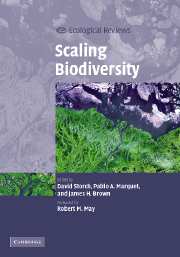Book contents
- Frontmatter
- Contents
- List of contributors
- Foreword by Robert M. May (Lord May of Oxford)
- Preface
- 1 Introduction: scaling biodiversity – what is the problem?
- PART I Spatial scaling of species richness and distribution
- 2 Species–area curves and the geometry of nature
- 3 The distribution of species: occupancy, scale, and rarity
- 4 Species distribution patterns, diversity scaling and testing for fractals in southern African birds
- 5 Geometry of species distributions: random clustering and scale invariance
- 6 Toward a mechanistic basis for a unified theory of spatial structure in ecological communities at multiple spatial scales
- PART II Alternative measures of biodiversity: taxonomy, phylogeny, and turnover
- PART III Scaling of biological diversity with energy and the latitudinal biodiversity gradient
- PART IV Processes, perspectives, and syntheses
- Index
- Plate section
- References
2 - Species–area curves and the geometry of nature
Published online by Cambridge University Press: 05 August 2012
- Frontmatter
- Contents
- List of contributors
- Foreword by Robert M. May (Lord May of Oxford)
- Preface
- 1 Introduction: scaling biodiversity – what is the problem?
- PART I Spatial scaling of species richness and distribution
- 2 Species–area curves and the geometry of nature
- 3 The distribution of species: occupancy, scale, and rarity
- 4 Species distribution patterns, diversity scaling and testing for fractals in southern African birds
- 5 Geometry of species distributions: random clustering and scale invariance
- 6 Toward a mechanistic basis for a unified theory of spatial structure in ecological communities at multiple spatial scales
- PART II Alternative measures of biodiversity: taxonomy, phylogeny, and turnover
- PART III Scaling of biological diversity with energy and the latitudinal biodiversity gradient
- PART IV Processes, perspectives, and syntheses
- Index
- Plate section
- References
Summary
Introduction
It is widely appreciated that species distributions and biodiversity can be strongly related to environmental factors. Likewise, it is recognized that increasing environmental heterogeneity with area is one of the determinants of species–area relationships. However, few theoretical treatments of species–area relationships specifically address how biodiversity's increase with scale should be related to the geometry of the environment. I hypothesize that this geometry is the underlying reason for the triphasic species–area curve.
Gradient analysis
One of the oldest, strongest and least contentious generalizations in ecology is that the spatial distribution of species is due, at least in part, to variation in the environment. In particular, the abundance of a species tends to be a unimodal function of important environmental variables (Whittaker, 1975; ter Braak, 1987; Austin & Gaywood, 1994). Such functions are termed species response curves, and graphs of the response curves for all species in a region combined or coenoclines (Fig. 2.1) are in almost all ecological textbooks (for example, Begon, Harper & Townsend, 1996; Ricklefs, 2001) and have played important roles in the development of ecological theory (Whittaker, 1972; Shmida & Ellner, 1984; Tilman, 1988). The study of how species respond to gradients in the environment is known as gradient analysis (Whittaker, 1967; Austin, 1987; ter Braak & Prentice, 1988).
The unimodal species response curve is a simple manifestation of a species having an optimum set of environmental conditions. As conditions deviate from the optimum, the species will occur in less abundance.
- Type
- Chapter
- Information
- Scaling Biodiversity , pp. 15 - 31Publisher: Cambridge University PressPrint publication year: 2007
References
- 21
- Cited by



